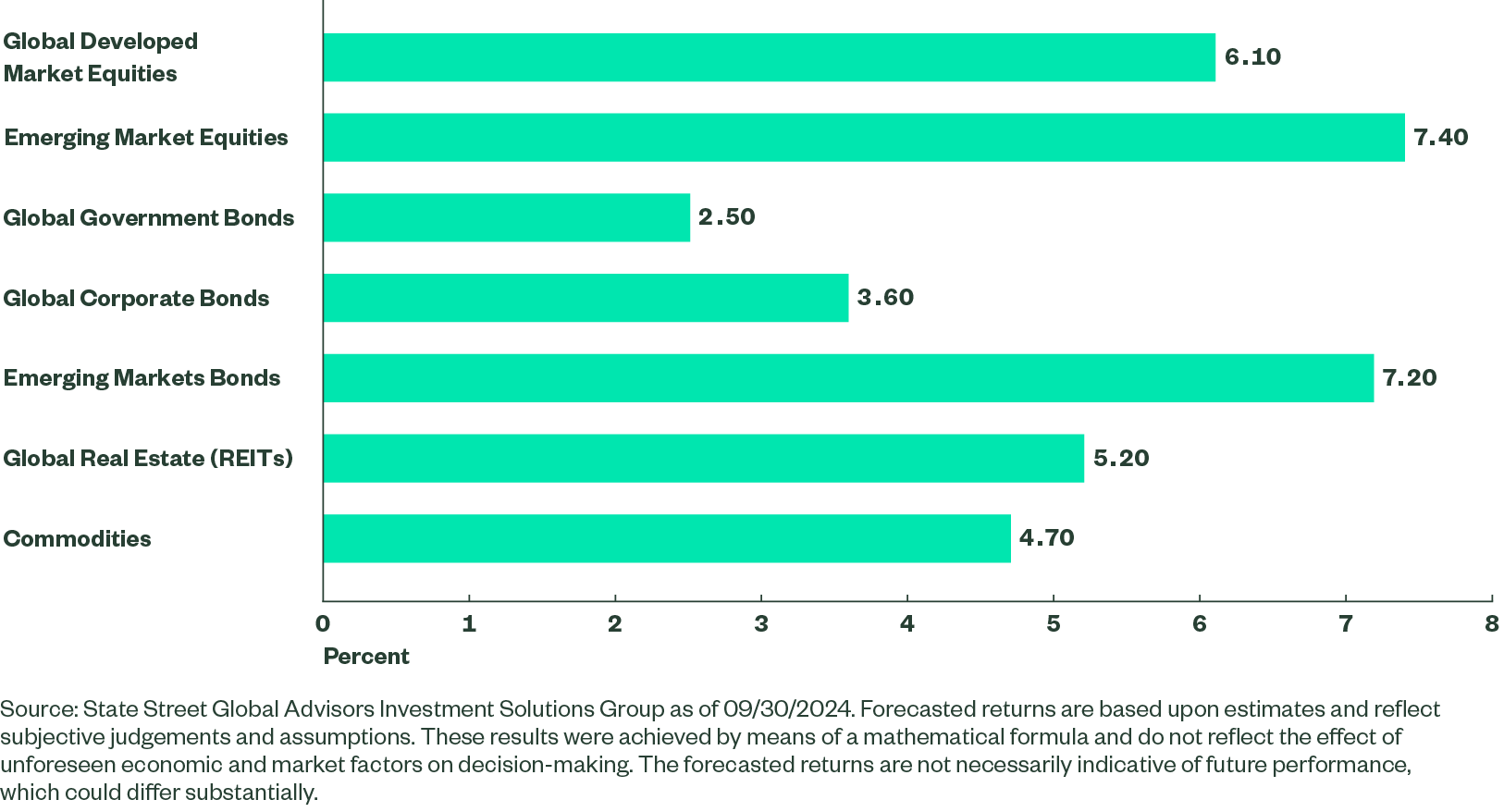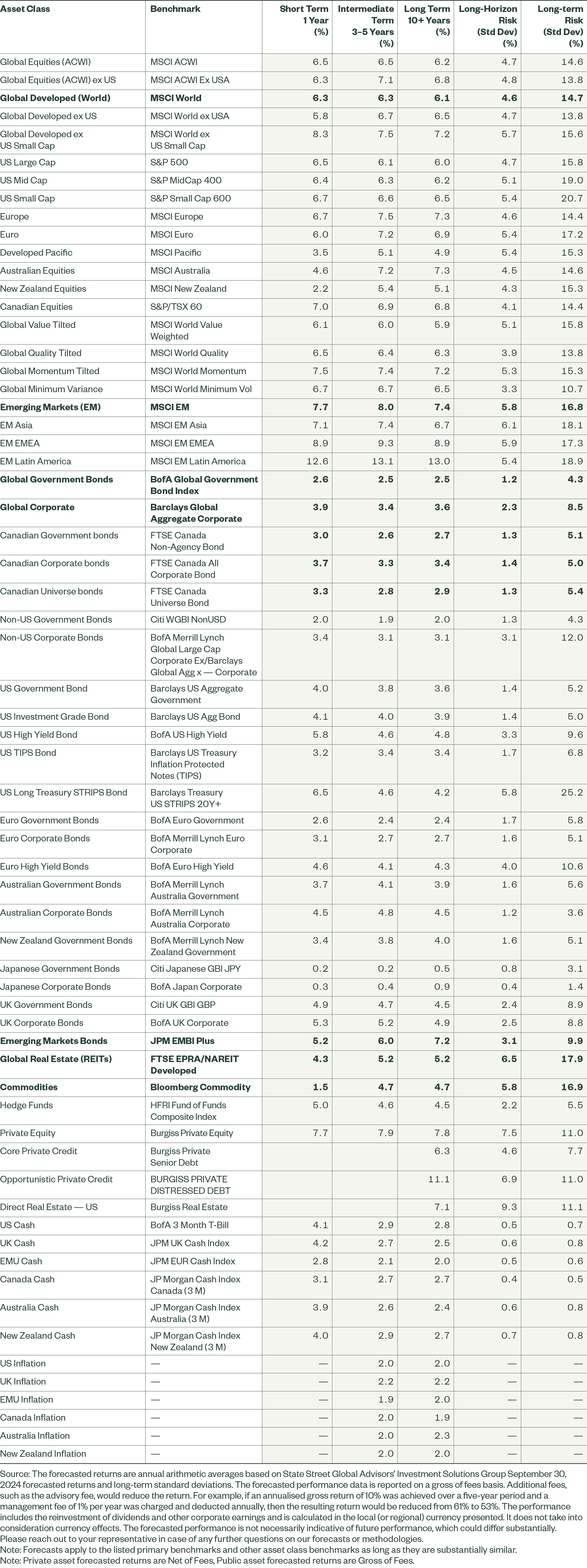Long-Term Asset Class Forecasts: Q4 2024
Our longer-term asset class forecasts are forward-looking estimates of total return and risk premia, generated through a combined assessment of current valuation measures, economic growth, inflation prospects, sustainability considerations, yield conditions as well as historical price patterns. We also include shorter-term return forecasts that incorporate output from our multi-factor tactical asset allocation models. Our latest forecasts are now available. Read more to learn about the process we use to arrive at our return forecasts for the major asset classes.
For a copy of the latest quarterly investment commentary from the Investment Solutions Group, please reach out to your State Street representative.
Inflation
The starting point for our nominal asset class return projections is an inflation forecast. We incorporate both estimates of long-term inflation and the inflation expectations implied in current bond yields. US Treasury Inflation-Protected Securities (TIPS) provide a market observation of the real yields that are available to investors. The difference between the nominal bond yield and the real bond yield at longer maturities furnishes a marketplace assessment of long-term inflation expectations.
Cash
Our long-term forecasts for global cash returns incorporate what we view as the normal real return that investors can expect to earn over time. Historically, cash investors have earned a modest premium over inflation but we also take current and forward-looking global central bank policy rates into consideration in formulating our cash forecast.
Bonds
Our return forecasts for fixed income are derived from current yield conditions together with expectations as to how real and nominal yield curves will evolve relative to historical precedent. We then build our benchmark forecasts from discrete analysis of relevant maturities. For corporate bonds, we also analyse credit spreads and their term structures, with separate assessments of investment grade and high yield bonds. We also take into account the default probability for high yield bonds in the foreseeable future.
Figure 1: Forecasted Long-Term Annualised Return (10+ Years)

Equities
Our long-term equity market return forecasts combine estimates of real return potential, derived from historical and current dividend yields, forecasted real earnings growth rates, expected share issuance or buyback yield, and potential for expansion or contraction of valuation multiples. Our way of estimating real earnings growth rates incorporates forecasts of GDP levels. Across both developed and emerging markets, variations in labour, capital and productivity levels result in region-specific differences in the GDP estimates, allowing for more region-appropriate forecasts for both developed and emerging market equities.
Another important feature of our equity forecasts is that they include elements of sustainability through leveraging State Street Global Advisors’ R-Factor scores. Improvements in a country’s aggregated and normalised R-Factor scores are used to incrementally reduce its risk expectations within the forecast and the other way around.
Smart Beta
Smart Beta forecasts are developed using MSCI World index forecasts as a starting point and adding expected alpha and beta adjustments as appropriate.
Private Equity
Our long-term forecast for private equity is based upon past performance patterns of private equity funds relative to listed equity markets and our extrapolation of these performance patterns on a forward basis. According to several academic studies1,2,3 the annual rate of return of private equity funds over the long term appears to be largely in line with that of listed equities after appropriate adjustments for leverage are made. Private equity funds seem to have been outperforming relative to listed equities before fees, but generally in line with them (on a leverage-adjusted basis) after fees.
REITs
Real Estate Investment Trusts (REITs) have historically earned returns between bonds and stocks due to their stable income streams and potential for capital appreciation. Hence, we model it as a blend of two approaches. The first approach is to apply the average historical spread of the yields over Treasuries to forecast the expected return. The second approach is to account for inflation and long-term capital appreciation with the current dividend yield.
Commodities
Our long-term commodity forecast is based on our forecasts for US inflation and the US Dollar Index. Since the exposure to commodities is primarily held through the Futures market, rolling the futures would be a source of return. For this, we use the long-term roll return along with the latest positioning of commodities futures. We also consider that collateral held for maintaining the exposure to futures shall generate a return.
Long Horizon Risk
We believe that over the long term, prices are anchored to some sort of a slow-moving, fundamentals-anchored process, while in the short term, these same prices cycle quasi-randomly around such anchors. Thus, the returns on most financial assets can be effectively separated into a long-term component linked to economic fundamentals and a transient part linked to “excess volatility” or other noise. Such property of asset returns rhythms nicely with the investors’ need to balance strategic portfolio optimality with the short-term risk control. With that in mind, we expanded our Long-Term Return Forecasts to include long-horizon risk estimates alongside ordinary, short-horizon ones.
Figure 2: Asset Class Return Forecasts
